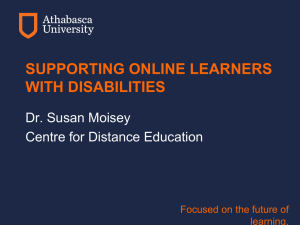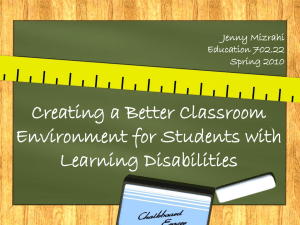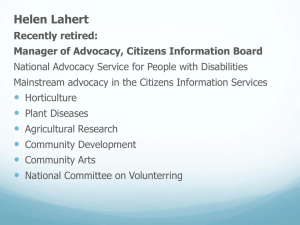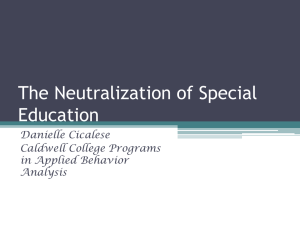Comprehensive Assessment and Evaluation of Students
advertisement
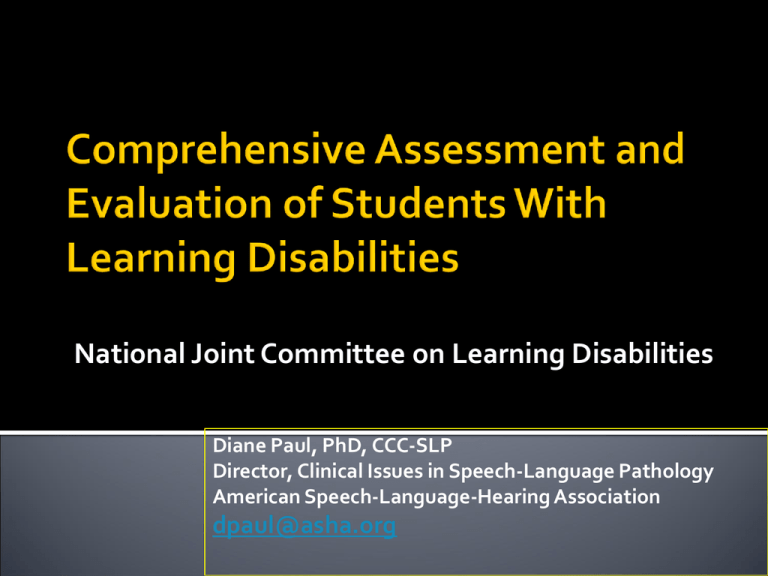
National Joint Committee on Learning Disabilities Diane Paul, PhD, CCC-SLP Director, Clinical Issues in Speech-Language Pathology American Speech-Language-Hearing Association dpaul@asha.org NJCLD strongly supports comprehensive assessment and evaluation of students with learning disabilities by a multidisciplinary team for the identification and diagnosis of students with learning disabilities. Requires the use of multiple data sources standardized tests, informal measures, observations, student self-reports, parent reports, and progress monitoring data from RTI approaches Reliance on any single criterion for assessment or evaluation is not comprehensive, nor is a group assessment (e.g., universal screening or statewide academic assessment tests) Identify a student’s patterns of strengths and needs Inform identification, eligibility, services, and instruction Collection of data through the use of multiple measures, including standardized and informal instruments and procedures Follows assessment Incorporates information from all data sources Process of integrating, interpreting, and summarizing comprehensive assessment data Critical for accurate diagnosis of learning disabilities ▪ Avoid identifying students as having LD when they don’t ▪ Avoid excluding students who have LD Legislation…. Two federal education laws, the Elementary and Secondary Education Act (ESEA—recently called the No Child Left Behind Act of 2001) and the Individuals with Disabilities Education Improvement Act of 2004 (IDEA 2004) ESEA provides for a group entitlement (i.e., providing programming regulations for all learners) IDEA is an entitlement for states to provide individual students who are found eligible with special education and related services Changes in ESEA and IDEA legislation Provide opportunities for students to participate in the general education curriculum Use quality reading and mathematics instruction designed to ensure that poor achievement is not a result of inappropriate or inadequate instruction Suggests response to intervention as an alternative to severe discrepancy between achievement and ability in the learning disabilities identification and eligibility process Other legislative changes….. Funding early intervening services Recognition of the importance of new technology Assistive technology Universal design for learning Summary of Performance (SOP), an organizational tool for postsecondary transition planning to provide information about the student’s high school experience and the supports needed in the next phase of life (e.g., college or career). Required for all students with an IEP graduating or exiting high school. Other legislative changes (con’t)….. Increased use of inclusive practices Participation in statewide assessment measures Standards-based reporting in adequate yearly progress (AYP) IEP goals linked to accountability Use of continuous monitoring of progress as formative assessment Research…. Use of the discrepancy model Skills critical to reading success in the early grades Implementation of response-based problem-solving models Research (con’t)…. Emerging research focusing on Encouraging quality and validity of RTI components (e.g., curriculum- based measurement, movement among tiers, cost effectiveness, maintenance of change over time) and of instruction (e.g., fidelity, intensity) Complexities of reading Cultural and linguistic diversity Noncognitive influences (e.g., motivation, engagement, self-efficacy) Brain function and genetics Accountability measures (e.g., growth models to track individual student achievement into statewide accountability data for calculation of AYP) Education….. Increase in number but not percentage of students identified as having LD Disproportional number of culturally and linguistically diverse LD students in special education Reduce “over-identification” of LD through RTI and other approaches Recognition of diverse student population Nonbiased assessment techniques Interpretation of assessment results for families and professionals on team Professional development Education (con't)… Focus on academic achievement standards and need for common core standards Instructionally linked assessments and use of progressmonitoring and other data Evidence-based instructional strategies, techniques, and curricula Individual differences in learning and need to individualize help for low achieving students Use of authentic learning materials observed in natural conditions Education (con't)… Development of individual transition plan (ITP) has changed from age 14 to age 16 years (IDEA 2004) Concern about the shorter planning time to support a successful transition from high school for each student Shift to SOP for reporting student academic achievement and functional performance instead of the previously mandated re-evaluation Discourage use of a severe discrepancy between achievement and ability Reduce reliance on a single data source Technological advances streamline and standardize data collection Recognizes intra-individual differences, variation in severity, and need for specialized instruction and accommodations. 2. No single data source is sufficient. 3. Professionals with expertise in learning disabilities are necessary to conduct a comprehensive assessment and evaluation system. 4. Multidisciplinary teams need to consider all aspects of a student’s learning and behavior. 1. 5. 6. 7. Teams need to differentiate learning disabilities from underachievement and other types of learning and behavior problems. Multidisciplinary teams need to consider and integrate assessment findings. Multidisciplinary teams work to ensure that administrators and families recognize the benefit of an accurate diagnosis to inform instruction. 1. 2. 3. Use a valid and the most current version of any standardized assessment. Use multiple measures, including both standardized and nonstandardized assessments Examine functioning and/or ability levels across domains motor, sensory, cognitive, communication, behavior perception; memory; attention; sequencing; motor planning and coordination; and thinking, reasoning, organization Adhere to the accepted and recommended procedures for administration, scoring, and reporting of standardized measures. 5. Integrate the standardized and informal data collected. 4. 7. Consider all components of the definition of learning disabilities in IDEA 2004 and/or its regulations, including the eight areas of specific learning disabilities (i.e., oral expression, listening comprehension, written expression, basic reading skill, reading comprehension, reading fluency, mathematics calculation, mathematics problem solving) exclusionary factors (not due primarily to intellectual disabilities, sensory impairments, emotional/social difficulties, cultural and linguistic factors, or adverse environmental conditions). 8. intra-individual differences (i.e., a pattern of strengths and weaknesses) Use data to inform decisions about identification, eligibility, services, and instructional planning. Characteristics of Learning Disabilities 1. 2. 3. 4. 5. Vary with the individual Exist on a continuum from mild to severe Can appear differently in various academic and nonacademic settings Vary in their manifestations depending on task demands and may include difficulties in language (i.e., listening, written and oral expression, spelling, reading), mathematics, handwriting, memory, perception, cognition, fine motor expression, social skills, and executive functions (e.g., attention, organization, reasoning) Can occur in students who are also gifted and/or talented Sensitivity to validity and reliability issues must be considered when assessing students from culturally and linguistically diverse backgrounds, including ELLs. Documentation of underachievement in one or more areas is a necessary, but not a sufficient criterion, for the diagnosis of learning disabilities. Continued learning problems following high-quality, research-based instruction can be an indication of learning disabilities; however, inadequate instruction does not preclude the possibility that a student has learning disabilities. Factors such as poor self-regulatory behaviors (e.g., inattention, lack of motivation, and impulsivity), poor social perception (e.g., inappropriate social judgment), and inappropriate social interaction (e.g., problems relating to peers) are not in themselves considered learning disabilities, but they may be concomitant with learning disabilities. Students with other conditions also may be diagnosed as having concomitant learning disabilities. Evidence of intra-individual differences in skills and performance can suggest learning disabilities. Eligibility: Determining Whether a Student Needs Special Education and Related Services Identify a student without regard to the prospects of the services Decision about diagnosis should not be based on any of the following factors: Absence of an appropriate placement or availability of services Lack of funds or resources Desire or intention to generate special education funds Make recommendations, including exploration of services under 504, for students who do not qualify Prepare written evaluation report (should be integrated multidisciplinary report) Determine eligibility Identify areas of strength and need, set goals, and determine appropriate services Link goals directly to the IFSP, IEP, ITP Data should guide both instruction and transition, if appropriate at elementary, middle, high school, private to public school, etc. Provide suggestions about student strengths and needs, accommodations, and assistive technology, support from related service providers, as well as suggested instructional, classroom management, and motivational strategies on the IEP, IFSP, ITP, or SOP, as appropriate. Research 1. 2. 3. 4. Guide selection of the most relevant and appropriate battery of assessment measures Identify and expand approaches to alternative models of assessment Collect data on older students on a variety of complex skills Develop assessment measures with adequate sensitivity and specificity with a focus on the issue of disproportionality in special education Research (con’t) 5. 6. 7. 8. Conduct large scale, longitudinal studies across states and local districts RTI research in such areas as intervention fidelity, effects in scaled-up models, longitudinal results, cost effectiveness, and maintenance of change over time Establish and expand longitudinal data bases to inform the field about optimal assessment protocols that are linked to student progress and outcomes Examine role and use of new technologies Professional Development 1. 2. 3. 4. Needed for all professionals on team Include information about influence of cultural and linguistic diversity on assessment Keep up to date about legislation, research, and education May want to develop individual professional growth plan Families and Advocates 1. 2. 3. Expand ways to involve families and other advocates Increase information and training Communicate necessity for early, collaborative, and focused transition assessment and planning Administration/Leadership 1. 2. 3. 4. Provide infrastructure and resources for effective assessment Provide leadership and logistical support to multidisciplinary assessment team members Examine relationship between curriculum, standards, and accountability measures Ensure use of nonbiased assessment measures Administration/Leadership (con’t) 5. 6. 7. Foster implementation of positive school practices based on research Ensure that gifted students with learning disabilities are provided with appropriate learning opportunities Clarify that intra-individual differences occur as a pattern of strengths and weaknesses in performance and/or achievement within specific domains, such as behavior, cognition, communication, and academics


